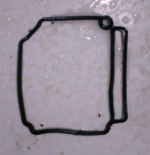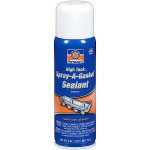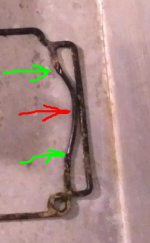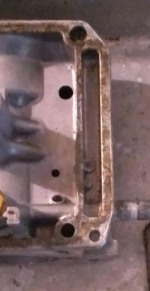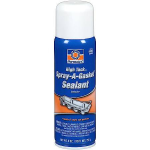So, I think this is the 4th carb now (3 different motors) that I have seen the gasket misaligned like this. My first impression was just sloppy work but now I'm wondering if there could be something in the design of the carb that causes this to happen from some pressure. The red arrow shows the gasket curved where it should be straight. Seems odd it should always be the same spot. I repeatedly put the bowl on and took it back off looking to see if the gasket moved but I could never duplicate the misalignment.
Hard to tell from the picture of its a rubber or fiber gasket.. either way, you do not reuse compression fit gaskets, period.
In either scenario, the gasket is “crushed” between the mating surfaces to make a seal. The cross section of the gasket and the amount of crush (percentage of thickness) required to seal the joint is determined by the gasket material and the pressure which it must maintain. The torque on the fasteners is determined by the hardness of the gasket and the surface area in which the gasket has to be crushed.
Flatness of the sealing surfaces, torque sequence and tolerance of the retaining fasteners and the gasket’s thickness and or distortion all play into a gaskets ability to seal.
As noted above, a gasket is distorted when crushed. Paper gaskets become thinner in the area of contact and get thinner yet in areas of higher compression, ie over torqued fastener or distorted sealing surfaces.
Rubber gaskets typically flatten out and take a hard set (flat spot) where the gasket was in contact with the mating surfaces.
On top of the distortion, gaskets swell (change dimensions) when exposed either direct or indirectly to media. Rubber (oring) gaskets are the worst. Not only do they get larger in diameter they also expand in physical size. The 1” square gasket that fit perfectly when new is now 1.12” square after exposure. This seems to be the case with the gasket in question which is why you typically see paper gaskets in use with hydrocarbon media.
Bottom line…don’t reuse gaskets in critical applications.
